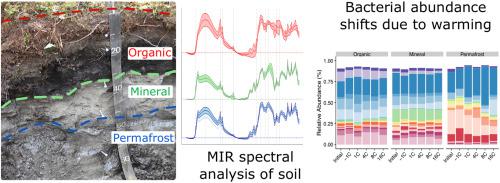Soil Biology and Biochemistry ( IF 9.8 ) Pub Date : 2020-06-23 , DOI: 10.1016/j.soilbio.2020.107882 Michael P. Ricketts , Roser Matamala , Julie D. Jastrow , Dionysios A. Antonopoulos , Jason Koval , Chien-Lu Ping , Chao Liang , Miquel A. Gonzalez-Meler

|
Soil microbial communities in the Arctic play a critical role in regulating the global carbon (C) cycle. Vast amounts of C are stored in northern high latitude soils, and rising temperatures in the Arctic threaten to thaw permafrost, making relatively inaccessible C sources more available for mineralization by soil microbes. Few studies have characterized how microbial community structure responds to thawing permafrost in the context of varying soil chemistries associated with contrasting tundra landscapes. We subjected active layer and permafrost soils from upland and lowland tundra sites on the North Slope of Alaska to a soil-warming incubation experiment and compared soil bacterial community profiles (obtained by 16S rRNA amplicon sequencing) before and after incubation. The influence of soil composition (characterized by mid-infrared [MIR] spectroscopy) on bacterial community structure and class abundance was analyzed using redundancy and correlation analyses. We found increased abundances of Alphaproteobacteria, Gammaproteobacteria, and Bacteroidetes [Sphingobacteriia] post incubation, particularly in permafrost soils. The categorical descriptors site and soil layer had the most explanatory power in our predictive models of bacterial community structure, highlighting the close relationship between soil bacteria and the soil environment. Specific soil chemical attributes characterizing the soil environments that were found to be the best predictors included MIR spectral bands associated with inorganic C, silicates, amide II (C N stretch), and carboxylics (C–O stretch), and MIR peak ratios representing C substrate quality. Overall, these results further characterize soil bacterial community shifts that may occur as frozen environments with limited access to C sources, as is found in undisturbed permafrost, transition to warmer and more C-available environments, as is predicted in thawing permafrost due to climate change.
N stretch), and carboxylics (C–O stretch), and MIR peak ratios representing C substrate quality. Overall, these results further characterize soil bacterial community shifts that may occur as frozen environments with limited access to C sources, as is found in undisturbed permafrost, transition to warmer and more C-available environments, as is predicted in thawing permafrost due to climate change.
中文翻译:

变暖和土壤化学成分对北极苔原土壤细菌群落结构的影响
北极的土壤微生物群落在调节全球碳(C)循环中起着至关重要的作用。大量的碳储存在北部的高纬度土壤中,北极地区的温度升高威胁着永久冻土的融化,使得相对难以接近的碳源更容易被土壤微生物矿化。很少有研究描述微生物群落结构如何在与冻原景观形成对比的土壤化学变化的背景下对永久冻土的融化作出反应。我们对来自阿拉斯加北坡高地和低地苔原站点的活性层和多年冻土进行了土壤保温实验,并比较了培养前后的土壤细菌群落特征(通过16S rRNA扩增子测序获得)。利用冗余度和相关分析,分析了土壤成分(以中红外光谱为特征)对细菌群落结构和类别丰度的影响。我们发现孵化后,尤其是在多年冻土中,α变形杆菌,γ变形杆菌和拟杆菌[Sphingobacteriia]的丰度增加。在我们的细菌群落结构预测模型中,分类描述符的位点和土壤层具有最强的解释力,突出了土壤细菌与土壤环境之间的密切关系。表征土壤环境的特定土壤化学特征是最佳的预测指标,其中包括与无机碳,硅酸盐,酰胺II(C 孵化后,特别是在多年冻土中的拟杆菌和拟杆菌[Sphingobacteriia]。在我们的细菌群落结构预测模型中,分类描述符的位点和土壤层具有最强的解释力,突出了土壤细菌与土壤环境之间的密切关系。表征土壤环境的特定土壤化学特性是最佳的预测指标,其中包括与无机碳,硅酸盐,酰胺II(C 孵化后,特别是在多年冻土中的拟杆菌和拟杆菌[Sphingobacteriia]。在我们的细菌群落结构预测模型中,分类描述符的位点和土壤层具有最强的解释力,突出了土壤细菌与土壤环境之间的密切关系。表征土壤环境的特定土壤化学特征是最佳的预测指标,其中包括与无机碳,硅酸盐,酰胺II(C N拉伸),羧基(C–O拉伸)和MIR峰比率代表C底物质量。总体而言,这些结果进一步表征了土壤细菌群落的变化,这可能发生在由于缺乏碳源而受到限制的冰冻环境中(如在未扰动的多年冻土中发现,过渡到较温暖和碳含量更高的环境中),正如气候变化导致的冻土融化所预测的那样。
N拉伸),羧基(C–O拉伸)和MIR峰比率代表C底物质量。总体而言,这些结果进一步表征了土壤细菌群落的变化,这可能发生在由于缺乏碳源而受到限制的冰冻环境中(如在未扰动的多年冻土中发现,过渡到较温暖和碳含量更高的环境中),正如气候变化导致的冻土融化所预测的那样。











































 京公网安备 11010802027423号
京公网安备 11010802027423号